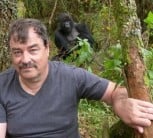A study by a team of scientists at the Max Delbrück Center for Molecular Medicine (MDC) in Berlin, Germany and the University of Pretoria (UP) has found that naked mole-rats can communicate with one another within their own colony. They do this with a unique dialect that is specific to that individual colony.
Naked mole-rats – rodents with a wrinkled, pink skin and large protruding teeth – live in large, underground families. Most studies to date have been focused on their unique physiological qualities, namely that they rarely get cancer, are resistant to some types of pain, can survive up to 18 minutes without oxygen, and live into their mid-30s, a remarkable feat for a small rodent.
“Naked mole-rats, one of only two eusocial (an extreme version of social group living) species of mammals, use shared dialects to strengthen unity of their large colonies,” reports the team, whose research article is featured on the cover of the prestigious journal Science. “The social and communication skills of human beings and naked mole-rats appear to have much more in common than anyone might have previously thought. Naked mole-rats have a linguistic culture that developed long before human beings even existed.”
“Naked mole-rats are very communicative creatures,” said Professor Gary Lewin, Head of the MDC’s Lewin Lab focused on the molecular physiology of somatic sensation. “If you stand outside their home and listen, you can hear the little rodents quietly chirping, squeaking, twittering, or even grunting to one another. We wanted to find out whether these vocalisations have a social function for the animals, who live underground together in an ordered colony with a strict division of labour.”
According to Professor Nigel Bennett, holder of the South African Research Chairs Initiative (SARChI) chair in Mammalian Behavioural Ecology and Physiology at UP’s Department of Zoology and Entomology in the Faculty of Natural and Agricultural Sciences, “Like other eusocial organisms such as termites, ants and bees, naked mole-rats live in large groups of around 40 to 50 animals which, in exceptional cases, can reach up to 300 with only one reproductive female, the queen, and one to three of the larger males responsible for reproduction. The remaining colony members are reproductively suppressed. Many species of mole-rat, naked mole-rats in particular, are extremely vocal, and it is of no surprise that they can identify one another by their vocalisations.”
The MDC and UP team, which includes Professor Gary Lewin, Dr Alison Barker, Lina Mograby, mathematician Grigorii Veviurko (who is now at the Delft University of Technology in the Netherlands), Professor Bennett and Dr Daniel Hart, set out to closely analyse the chirps that the naked mole-rats use to greet one another. “In so doing, we established that each colony has its own distinct dialect,” reports Dr Barker, lead author of the study. “The development of a shared dialect strengthens cohesion and a sense of belonging among the naked mole-rats of a specific colony.”
In order to analyse the naked mole-rats’ language, over a period of two years the research team recorded a total of 36 190 chirps made by 166 individuals from seven naked mole-rat colonies held in laboratories at Berlin and at UP. Prof Lewin’s team used an algorithm to analyse the acoustic properties of the individual vocalisations. “That enabled us to collect and compare eight different factors, such as the height or level of asymmetry in the sound spectrogram,” explained Prof Lewin.
Veviurko also developed a computer programme that, after an initial training period, was able to reliably detect which chirps came from which individual naked mole-rat. “We knew that each naked mole-rat has its own voice. What we did not know, however, was whether the animals could recognise one another from their voices,” Dr Barker said.
The computer programme, which uses artificial intelligence, did not only identify the animals on the basis of their individual voices, but also detected similarities in the types of sounds made within a single colony. The programme was able to identify which colony a specific individual came from. “Surprisingly, that meant that each colony probably had its own distinct dialect,” Dr Barker said. At that point, the research team did not yet know whether the animals were aware of that, and whether they could recognise their own dialect and distinguish it from others.
After a series of playback experiments it was observed that if the sounds were made by an individual from the test subject’s own colony, it would give an immediate vocal response, but if they were made by an individual from a foreign colony, the mole-rat would remain silent. “That enabled us to infer that naked mole-rats can recognise their own dialect and will selectively respond to that,” Dr Barker said. In further experiments the researchers placed three orphaned naked mole-rat pups in foreign colonies where the queen had also recently had a litter. Six months later, the computer programme showed that the foster pups had acquired the dialect of their new home.
The team said the next step is to find out what mechanisms in the animals’ brains support this culture of communication, as this could provide important insights into how human culture evolved. With access to many other species of African mole-rats and with hundreds of hours of observation on the only other eusocial mammal species (the Damaraland mole-rat) under his belt, Prof Bennett believes that this is only the tip of the iceberg, and that with further analysis and continued collaboration with the world’s best at the MDC, the evolution of vocal communication lies at the tips of our fingers.
Click on the gallery in the sidebar to view a selection of images showing how mole rats live and communicate.
Prof Nigel Bennett
January 21, 2021


 Story
Story
The latest issue of the University of Pretoria’s award-winning RE.SEARCH magazine is available now and reflects a shift towards both a fresher design and outlook. This edition is curated under the theme ‘Digital’, and offers a glimpse into some of the fascinating research we’re doing at UP to drive digital leadership and innovation.
 Story
Story
The articles in this edition showcase work from all nine of our faculties, and underscore our University’s slogan ‘Make today matter’. RE.SEARCH has been named South Africa's top corporate publication as the winner of the 2024 SA Publication's Forum Awards. It is a runner up and finalist in the Excellence category for Communication (runner up), Design and Photography (finalist) and the...
 Story
Story
Over the past two decades, field trips in search of dung beetles have taken University of Pretoria (UP) doctoral student Christian Deschodt across Southern Africa. But it was a well-trodden walk to fetch his kids from school, a mere 1,5km from his home near Hartbeespoort, that saw him stumble upon an entirely new species.
Copyright © University of Pretoria 2025. All rights reserved.
Get Social With Us
Download the UP Mobile App